Non-Technical Barriers to Energy Efficient Renovation of Residential Buildings and Potential Policy Instruments to overcome Them—Evidence from Young Russian Adults
Abstract
:1. Introduction
1.1. Russian Housing
1.2. Non-Technical Barriers for Energy Efficient Renovations
2. Materials and Methods
- Categorizing and analyzing renovation related policy instruments discussed in the scientific literature
- Formulating and performing the preliminary questionnaire
- Analyzing the results of the questionnaire
- Defining the main target questions for the semi-structured interviews and formulating the general structure of those interviews
- Performing the semi-structured interviews
- Analyzing the results of the semi-structured interviews
- Giving a suggestion on effective policy instruments in Russia and validating the suggestion by interviewing selected Finnish Russian experts in Finland.
- The participants were asked to present their opinion on the benefits and drawbacks of refurbishment but also on demolition and rebuilding in case of an old, deteriorated building.
- The participants were asked to distribute 10 points between a set of policy instruments (presented in Table 1) according to how (a) effective, and (b) feasible they could be in speeding up energy efficient renovation in Russia.
- The participants were encouraged to have free discussion about the role of the public sector in promoting energy efficient refurbishment activities in Russia.
3. Results
3.1. Renovation Related Policy Instruments
3.2. Results on Questionnaires
“Nowadays Russian government is capable to improve and refurbish energy efficient technology but I guess it’s quite new for us and we don’t know what to do in order to reach great quality.”“[Energy efficient refurbishment] becomes more popular. The companies which provide such options are learning from the foreign experience.”“Unfortunately, nowadays we haven’t enough support from Government for reconstruction and energy efficient refurbishment of residential houses. In the view of customers the level is high (of course to save money), but in my opinion there are no instructions from builders for new technologies and for the building development industry.”“Almost nobody is interested in energy saving. People just got used to high running costs.”
“I think if it [the building] is in very bad condition it is much better to demolish it. Old buildings are not energy efficient and very massive.”“It depends on the condition of the building (and which part is damaged more dangerously: wall constructions, basement, engineering systems etc.). Sometimes renovation of an old building costs more than to demolish. This is the reason to demolish building and build new ones instead of renovation.”
3.3. Results on Semi-Structured Interviews
3.4. Selected Policy Instruments to Overcome Barriers
- 4.
- How relevant are the suggested barriers in the Russian context?
- 5.
- How efficient could the presented policy instruments be if they were implemented?
- 6.
- How likely is it that the policy instruments will be implemented in Russia?
4. Discussion
5. Conclusions and Policy Implications
Acknowledgments
Author Contributions
Conflicts of Interest
References
- International Finance Corporation (IFC) and World Bank. Energy Efficiency in Russia: Untapped Reserves. In World Bank Group Working Paper; International Finance Corporation (IFC) and World Bank: Washington, DC, USA, 2008. [Google Scholar]
- Martinot, E. Energy efficiency and renewable energy in Russia. Energy Policy 1998, 26, 905–915. [Google Scholar] [CrossRef]
- Matrosov, Y.A.; Butovsky, I.N.; Watson, R.K. Case studies of energy consumption in residential buildings in Russia’s middle belt area. Energy Build. 1994, 20, 231–241. [Google Scholar] [CrossRef]
- Matrosov, Y.A.; Norford, L.K.; Opitz, M.W.; Butovsky, I.N. Standards for heating energy use in Russian buildings: A review and a report of recent progress. Energy Build. 1997, 25, 207–222. [Google Scholar] [CrossRef]
- Opitz, M.W.; Norford, L.K.; Matrosov, Y.A.; Butovsky, I.N. Energy consumption and conservation in the Russian apartment building stock. Energy Build. 1997, 25, 75–92. [Google Scholar] [CrossRef]
- International Finance Corporation (IFC). Analysis of International Best Practice in Organizing and Financing Capital Repairs and Energy Efficiency Modernizations of Multi-Family Buildings in Central and Eastern Europe; International Finance Corporation: Washington, DC, USA, 2011. [Google Scholar]
- Filippov, S.P. Development of centralized district heating in Russia. Therm. Eng. 2009, 56, 985–997. [Google Scholar] [CrossRef]
- Garbuzova, M.; Madlener, R. Towards an efficient and low carbon economy post-2012: Opportunities and barriers for foreign companies in the Russian energy market. Mitig. Adapt. Strateg. Glob. Chang. 2011, 17, 387–413. [Google Scholar] [CrossRef]
- Matrosov, Y.A.; Chao, M.; Majersik, C. Increasing Thermal Performance and Energy Efficiency of Buildings in Russia: Problems and Solutions. In Build. X, ASHRAE; Centre on Energy Efficiency: Moscow, Russia, 2007. [Google Scholar]
- Bashmakov, I. Resource of energy efficiency in Russia: Scale, costs, and benefits. Energy Effic. 2009, 2, 369–386. [Google Scholar] [CrossRef]
- Paiho, S.; Hedman, Å.; Abdurafikov, R.; Hoang, H.; Sepponen, M.; Kouhia, I.; Meinander, M. Energy saving potentials of Moscow apartment buildings in residential districts. Energy Build. 2013, 66, 706–713. [Google Scholar] [CrossRef]
- Paiho, S.; Hoang, H.; Hedman, Å.; Abdurafikov, R.; Sepponen, M.; Meinander, M. Energy and emission analyses of renovation scenarios of a Moscow residential district. Energy Build. 2014, 76, 402–413. [Google Scholar] [CrossRef]
- Milov, V.; Coburn, L.L.; Danchenko, I. Russia’s Energy Policy, 1992–2005. Eurasian Geogr. Econ. 2006, 47, 285–313. Available online: http://www.tandfonline.com/doi/abs/10.2747/1538-7216.47.3.285 (accessed on 27 May 2016). [CrossRef]
- Ministry of Energy of the Russian Federation. Energy Strategy of Russia for the Period up to 2030. Available online: http://www.energystrategy.ru/projects/docs/ES-2030_(Eng).pdf (accessed on 27 May 2016).
- Malmendier, B. New Russian Energy Efficiency Act. J. Energy Nat. Resour. Law. 2011, 29, 177–208. [Google Scholar] [CrossRef]
- Henry, L.A.; Sundstrom, L.M. Russia’s Climate Policy: International Bargaining and Domestic Modernisation. Eur. Asia. Stud. 2012, 64, 1297–1322. Available online: http://www.tandfonline.com/doi/abs/10.1080/09668136.2012.701388 (accessed on 27 May 2016). [CrossRef]
- Banfi, S.; Farsi, M.; Filippini, M.; Jakob, M. Willingness to pay for energy-saving measures in residential buildings. Energy Econ. 2008, 30, 503–516. [Google Scholar] [CrossRef]
- Williams, K.; Gupta, R.; Hopkins, D.; Gregg, M.; Payne, C.; Joynt, J.L.R.; Smith, I.; Bates-Brkljac, N. Retrofitting England’s suburbs to adapt to climate change. Build. Res. Inf. 2013, 41, 517–531. [Google Scholar] [CrossRef]
- Theodoridou, I.; Papadopoulos, A.M.; Hegger, M. A feasibility evaluation tool for sustainable cities—A case study for Greece. Energy Policy 2012, 44, 207–216. [Google Scholar] [CrossRef]
- Achtnicht, M. Do environmental benefits matter? Evidence from a choice experiment among house owners in Germany. Ecol. Econ. 2011, 70, 2191–2200. [Google Scholar] [CrossRef]
- Dowson, M.; Poole, A.; Harrison, D.; Susman, G. Domestic UK retrofit challenge: Barriers, incentives and current performance leading into the Green Deal. Energy Policy 2012, 50, 294–305. [Google Scholar] [CrossRef]
- Davies, P.; Osmani, M. Low carbon housing refurbishment challenges and incentives: Architects’ perspectives. Build. Environ. 2011, 46, 1691–1698. [Google Scholar] [CrossRef]
- Lowe, R.; Oreszczyn, T. Regulatory standards and barriers to improved performance for housing. Energy Policy 2008, 36, 4475–4481. [Google Scholar] [CrossRef]
- Weiss, J.; Dunkelberg, E.; Vogelpohl, T. Improving policy instruments to better tap into homeowner refurbishment potential: Lessons learned from a case study in Germany. Energy Policy 2012, 44, 406–415. [Google Scholar] [CrossRef]
- Hoppe, T. Adoption of innovative energy systems in social housing: Lessons from eight large-scale renovation projects in The Netherlands. Energy Policy 2012, 51, 791–801. [Google Scholar] [CrossRef]
- Paiho, S.; Abdurafikov, R.; Hoang, H.; Kuusisto, J. An analysis of different business models for energy efficient renovation of residential districts in Russian cold regions. Sustain. Cities Soc. 2015, 14, 31–42. [Google Scholar] [CrossRef]
- Boute, A. Energy Efficiency as a New Paradigm of the European External Energy Policy: The Case of the EU—Russian Energy Dialogue. Eur. Asia Stud. 2013, 65, 1021–1054. [Google Scholar] [CrossRef]
- Ürge-Vorsatz, D.; Koeppel, S.; Mirasgedis, S. Appraisal of policy instruments for reducing buildings’ CO2 emissions. Build. Res. Inf. 2007, 35, 458–477. [Google Scholar] [CrossRef]
- Federal State Statistics Service. Russia in Figures 2016. Statistical Handbook; 2016. Available online: http://www.gks.ru/bgd/regl/b16_12/Main.htm (accessed on 27 May 2016).
- Federal Service for State Statistics. Housing Stock and Services for Population in Russia 2013. Available online: http://www.gks.ru/wps/wcm/connect/rosstat_main/rosstat/ru/statistics/publications/catalog/doc_1138887300516 (accessed on 27 May 2016). (In Russian)
- Nekrasov, A.S.; Voronina, S.A.; Semikashev, V.V. Problems of residential heat supply in Russia. Stud. Russ. Econ. Dev. 2012, 23, 128–134. [Google Scholar] [CrossRef]
- International Finance Corporation (IFC) & European Bank for Reconstruction and Development (EBRD). Financing Capital Repairs and Energy Efficiency Improvements in Russian Multi-Family Apartment Buildings. 2012. Available online: http://www.ebrd.com/downloads/sector/sei/capital-repairs.pdf (accessed on 26 May 2017).
- Leonova, L.; Alpatova, Е.; Kowalczyk, S.; Rutkauskas, T. Humanization of the Russian housing model in the postmodern space. ICSC 2016 E3S Web Conf. 2016, 6, 01003. [Google Scholar] [CrossRef]
- The Institute of Urban Economics (IUE) for the European Bank for Reconstruction and Development (EBRD). Analyse the Current State of the Housing Stock (Report on Task 1). Russian Urban HousingEnergy Efficiency Programme—Model Development. 2011. Available online: http://www.ebrd.com/downloads/sector/sei/report2.pdf (accessed on 27 May 2016).
- Federal State Statistics Service, Russia 2015. Statistical Pocketbook; 2015. Available online: http://www.gks.ru/free_doc/doc_2015/rus15_eng.pdf (accessed on 27 May 2016).
- Shomina, E.; Heywood, F. Transformation in Russian housing: The new key roles of local authorities. Int. J. Hous. Policy 2013, 13, 312–324. [Google Scholar] [CrossRef]
- Masokin, M. The Future of Cogeneration in Europe: Growth Opportunities and Key Drivers of Success; Business Insights Limited: Warwick, UK, 2007. [Google Scholar]
- Nuorkivi, A.; Kalkum, B. Policies and barriers for district heating and cooling outside the EU Countries. In Proceedings of the 35 th Euroheat & Power Congress, Pairs, France, 9–10 May 2011. [Google Scholar]
- Eliseev, K. District Heating Systems in Finland and in Russia. Mikkeli University of Applied Sciences. 2011. Available online: http://lib.tkk.fi/Diss/2005/isbn9512275422/isbn9512275422.pdf (accessed on 27 May 2016).
- Paiho, S.; Abdurafikov, R.; Hoang, H. Cost analyses of energy-efficient renovations of a Moscow residential district, Sustain. Cities Soc. 2015, 14, 5–15. [Google Scholar] [CrossRef]
- Federal State Statistics Service, Online Databases. Available online: http://www.gks.ru/wps/wcm/connect/rosstat main/rosstat/en/main/ (accessed on 18 June 2014).
- Korppoo, A.; Korobova, N. Modernizing residential heating in Russia: End-use practices, legal developments, and future prospects. Energy Policy 2012, 42, 213–220. [Google Scholar] [CrossRef]
- RuSEFF-Residential. Legislative and Regulatory Framework for Planning and Implementing Capital Repairs and Modernization of Housing Stock in the Russian Federation; RuSEFF-Residential, 2013. Available online: http://www.ruseff-r.ru/sites/default/files/downloads/legal_renovation_guideline_en_0.pdf (accessed on 27 May 2017).
- Kuleshov, D.; Viljainen, S.; Annala, S.; Gore, O. Russian electricity sector reform: Challenges to retail competition. Util. Policy 2012, 23, 40–49. [Google Scholar] [CrossRef]
- Medineckienė, M.; Björk, F. Owner preferences regarding renovation measures—The demonstration of using multi-criteria decision making. J. Civ. Eng. Manag. Available online: http://www.tandfonline.com/doi/abs/10.3846/13923730.2011.582380 (accessed on 27 May 2016).
- Baek, C.; Park, S. Policy measures to overcome barriers to energy renovation of existing buildings. Renew. Sustain. Energy Rev. 2012, 16, 3939–3947. [Google Scholar] [CrossRef]
- Stieß, I.; Dunkelberg, E. Objectives, barriers and occasions for energy efficient refurbishment by private homeowners. J. Clean. Prod. 2013, 48, 250–259. [Google Scholar] [CrossRef]
- Jones, P.; Lannon, S.; Patterson, J. Retrofitting existing housing: How far, how much? Build. Res. Inf. 2013, 41, 532–550. [Google Scholar] [CrossRef]
- Du, P.; Zheng, L.-Q.; Xie, B.-C.; Mahalingam, A. Barriers to the adoption of energy-saving technologies in the building sector: A survey study of Jing-jin-tang. China Energy Policy 2014, 75, 206–216. [Google Scholar] [CrossRef]
- Paiho, S.; Abdurafikov, R.; Hedman, Å.; Hoang, H.; Kouhia, I.; Meinander, M. Malin Sepponen, Energy-efficient renovation of Moscow apartment buildings and residential districts, Espoo. 2013. Available online: http://www.vtt.fi/inf/pdf/technology/2013/T82.pdf (accessed on 27 May 2016).
- Schelly, C. Residential solar electricity adoption: What motivates, and what matters? A case study of early adopters. Energy Res. Soc. Sci. 2014, 21, 83–191. [Google Scholar] [CrossRef]
- Högberg, L.; Lind, H.; Grange, K. Incentives for improving energy efficiency when renovating large-scale housing estates: A case study of the swedish million homes programme. Sustainability 2009, 1, 1349–1365. [Google Scholar] [CrossRef]
- Friege, J.; Chappin, E. Modelling decisions on energy-efficient renovations: A review. Renew. Sustain. Energy Rev. 2014, 39, 196–208. [Google Scholar] [CrossRef]
- Power, A. Does demolition or refurbishment of old and inefficient homes help to increase our environmental, social and economic viability? Energy Policy 2008, 36, 4487–4501. [Google Scholar] [CrossRef]
- Tuominen, P.; Klobut, K.; Tolman, A.; Adjei, A.; de Best-Waldhober, M. Energy savings potential in buildings and overcoming market barriers in member states of the European Union. Energy Build. 2012, 51, 48–55. [Google Scholar] [CrossRef]
- Ástmarsson, B.; Jensen, P.A.; Maslesa, E. Sustainable renovation of residential buildings and the landlord/tenant dilemma. Energy Policy 2013, 63, 355–362. [Google Scholar] [CrossRef]
- Baek, C.-H.; Park, S.-H. Changes in renovation policies in the era of sustainability. Energy Build. 2012, 47, 485–496. [Google Scholar] [CrossRef]
- Charlier, D.; Risch, A. Evaluation of the impact of environmental public policy measures on energy consumption and greenhouse gas emissions in the French residential sector. Energy Policy 2012, 46, 170–184. [Google Scholar] [CrossRef]
- Dowling, R.; McGuirk, P.; Bulkeley, H. Retrofitting cities: Local governance in Sydney, Australia. Cities 2014, 38, 18–24. [Google Scholar] [CrossRef] [Green Version]
- Galvin, R. Thermal upgrades of existing homes in Germany: The building code, subsidies, and economic efficiency. Energy Build. 2010, 42, 834–844. [Google Scholar] [CrossRef]
- Gram-Hanssen, K. Existing buildings—Users, renovations and energy policy. Renew. Energy 2014, 61, 136–140. [Google Scholar] [CrossRef]
- Gupta, R.; Barnfield, L.; Hipwood, T. Impacts of community-led energy retrofitting of owner-occupied dwellings. Build. Res. Inf. 2014, 42, 446–461. [Google Scholar] [CrossRef]
- Van der Heijden, J. Voluntary programmes for building retrofits: Opportunities, performance and challenges. Build. Res. Inf. 2014, 43, 170–184. [Google Scholar] [CrossRef]
- Karvonen, A. Towards systemic domestic retrofit: A social practices approach. Build. Res. Inf. 2013, 41, 563–574. [Google Scholar] [CrossRef]
- Lewis, R. The determinants of renovation and redevelopment in Baltimore City. Reg. Sci. Policy Pract. 2012, 4, 335–354. [Google Scholar] [CrossRef]
- Lloyd, C.R.; Callau, M.F.; Bishop, T.; Smith, I.J. The efficacy of an energy efficient upgrade program in New Zealand. Energy Build. 2008, 40, 1228–1239. [Google Scholar] [CrossRef]
- Meijer, F.; Itard, L.; Sunikka-Blank, M. Comparing European residential building stocks: Performance, renovation and policy opportunities. Build. Res. Inf. 2010, 37, 533–551. Available online: http://www.tandfonline.com/doi/abs/10.1080/09613210903189376 (accessed on 27 May 2016). [CrossRef]
- Murphy, L.; Meijer, F.; Visscher, H. A qualitative evaluation of policy instruments used to improve energy performance of existing private dwellings in the Netherlands. Energy Policy 2012, 45, 459–468. [Google Scholar] [CrossRef]
- Murphy, L. The policy instruments of European front-runners: Effective for saving energy in existing dwellings? Energy Effic. 2014, 7, 285–301. [Google Scholar] [CrossRef]
- Nauleau, M.-L. Free-riding on tax credits for home insulation in France: An econometric assessment using panel data. Energy Econ. 2014, 46, 78–92. [Google Scholar] [CrossRef]
- Rosenow, J.; Platt, R.; Demurtas, A. Fiscal impacts of energy efficiency programmes—The example of solid wall insulation investment in the UK. Energy Policy 2014, 74, 610–620. [Google Scholar] [CrossRef]
- Sunikka, M. Policies for Improving Energy Efficiency in the European Housing Stock; Delft University: Delft, The Netherlands, 2006. [Google Scholar]
- Sunikka-Blank, M.; Chen, J.; Britnell, J.; Dantsiou, D. Improving Energy Efficiency of Social Housing Areas: A Case Study of a Retrofit Achieving an “A” Energy Performance Rating in the UK. Eur. Plan. Stud. 2012, 20, 131–145. [Google Scholar] [CrossRef]
- Uihlein, A.; Eder, P. Policy options towards an energy efficient residential building stock in the EU-27. Energy Build. 2010, 42, 791–798. [Google Scholar] [CrossRef]
- The Housing and Utilities Sector Reform Fund. Implementation of Regional Programmes, Results as of November 18, 2013. Available online: http://www.fondgkh.ru/result/result/get_finance/index.html (accessed on 17 December 2013). (In Russian).
- Lychuk, T.; Halverson, M.; Roshchanka, V. Analysis of the Russian Market for Building Energy Efficiency. 2012. Available online: /citations?view_op=view_citation&continue=/scholar%3Fhl%3Den%26as_sdt%3D1,5%26scilib%3D1&citilm=1&citation_for_view=n2mStcoAAAAJ:mUJArPsKIAAC&hl=en&oi=p (accessed on 27 May 2016).
- Sinyak, Y.V.; Nekrasov, A.S.; Voronina, S.A.; Semikashev, V.V.; Kolpakov, A.Y. Russia’s energy systems: Opportunities and prospects. Stud. Russ. Econ. Dev. 2013, 24, 1–14. [Google Scholar] [CrossRef]
- International Energy Agency (IEA). Energy Policies Beyond IEA Countries—Russia 2014. Executive Sumnary. Available online: http://www.iea.org/Textbase/npsum/russia2014sum.pdf (accessed on 27 May 2016).
- Paiho, S.; Abdurafikov, R.; Hoang, H.; Castell-Rüdenhausen, M.; Hedman, Å.; Kuusisto, J. Business aspects of energy-efficient renovations of Soviet-era residential districts. A Case Study from Moscow; VTT: Espoo, Finland, 2014; Available online: http://www.vtt.fi/inf/pdf/technology/2014/T154.pdf (accessed on 27 May 2016).
- Paiho, S. Energy-Efficient Renovation of Residential Districts. Cases from the Russian Market; VTT: Espoo, Finland, 2014; Available online: http://www.vtt.fi/inf/pdf/science/2014/S72.pdf (accessed on 27 May 2016).
- Nuorkivi, A. To the Rehabilitation Strategy of District Heating in Economies in Transition. 2005. Available online: http://lib.tkk.fi/Diss/2005/isbn9512275422/isbn9512275422.pdf (accessed on 27 May 2016).
- Statistics Finland, Blocks of Flats in Finland, As of 31.12.2012 & Number of Buildings by Intended Use and Heating Fuel on 31 December 2012. Available online: http://www.tilastokeskus.fi/til/rakke/tau.html (accessed on 28 April 2014).
- Dvarioniene, J.; Gurauskiene, I.; Gecevicius, G.; Trummer, D.R.; Selada, C.; Marques, I.; Cosmi, C. Stakeholders involvement for energy conscious communities: The Energy Labs experience in 10 European communities. Renew. Energy 2015, 75, 512–518. [Google Scholar] [CrossRef]
- Russian Social Ecological Union. Energy Efficiency in Russia: Sloping to Zero. Available online: http://rusecounion.ru/eng_enef_5115 (accessed on 27 May 2016).
- European Bank for Reconstruction and Development (EBRD). The EBRD in Russia. Available online: http://www.ebrd.com/russia.html (accessed on 27 May 2016).
- Hilke, A.; Ryan, L. Mobilising investment in energy efficiency: Economic instruments for low energy buildings. IEA Energy Pap. 2012, 10, 156. [Google Scholar]
- Ahonen, T.; Luoranen, M.; Ahola, J.; Tuunanen, J. Applying Nordic Energy Efficiency and Renewable Energy Solutions in Kaliningrad Oblast, Russia, Lappeenranta. 2013. Available online: http://www.doria.fi/bitstream/handle/10024/93894/RENSOL-report-eng_1510.pdf?sequence=2 (accessed on 15 June 2016).
- Nystedt, Å.; Sepponen, M.; Teerimo, S.; Nummelin, J.; Virtanen, M.; Lahti, P. Eco Grad. Concept for Ecological city Planning for St. Petersburg, Russia. 2010. Available online: http://www.vtt.fi/inf/pdf/tiedotteet/2010/T2566.pdf (accessed on 15 June 2016).
- The European Commission and the Russian Government. Roadmap—EU-Russia Energy Cooperation until 2050. 2013. Available online: http://ec.europa.eu/energy/international/russia/doc/2013_03_eu_russia_roadmap_2050_signed.pdf (accessed on 15 June 2016).
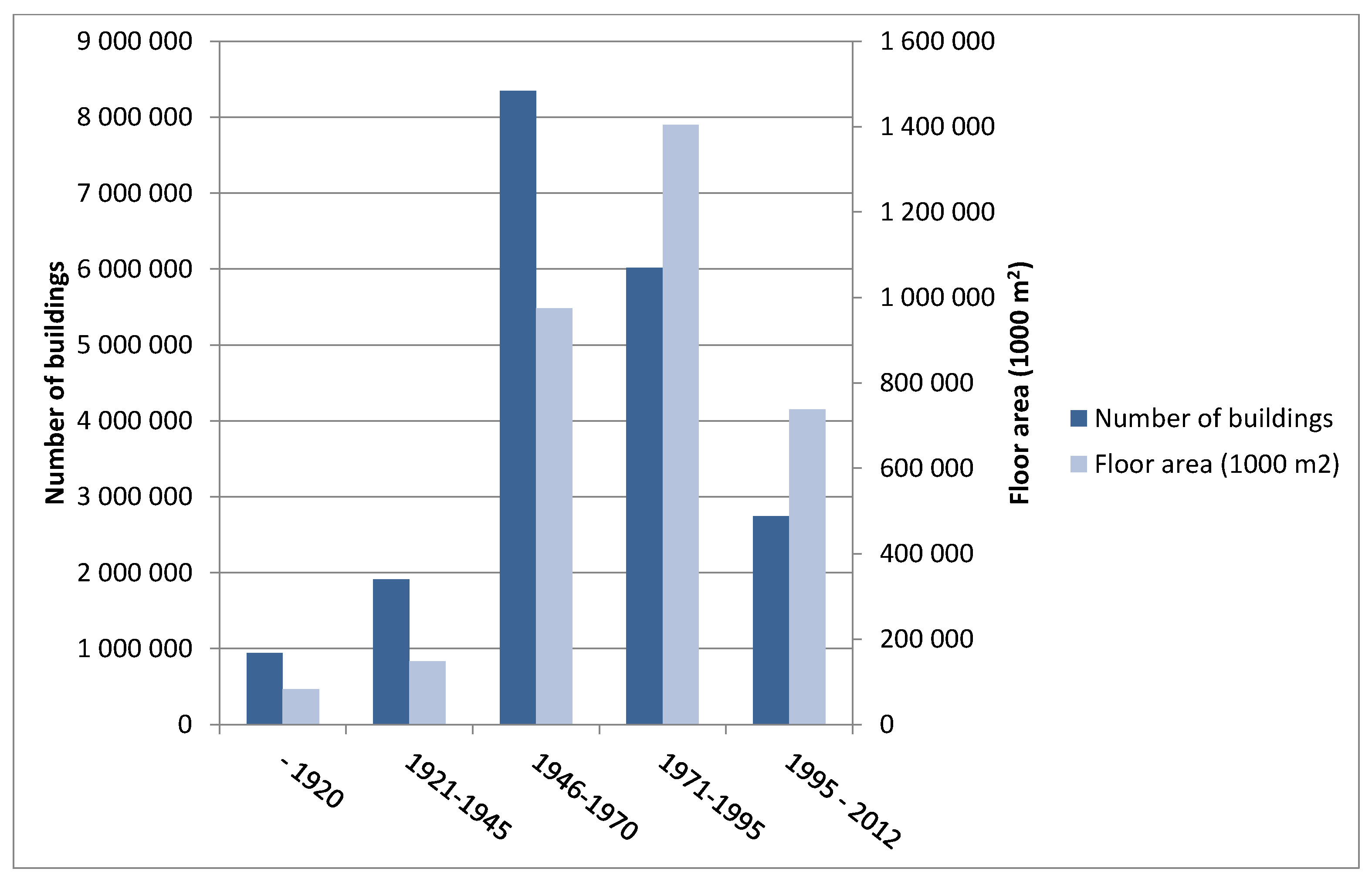
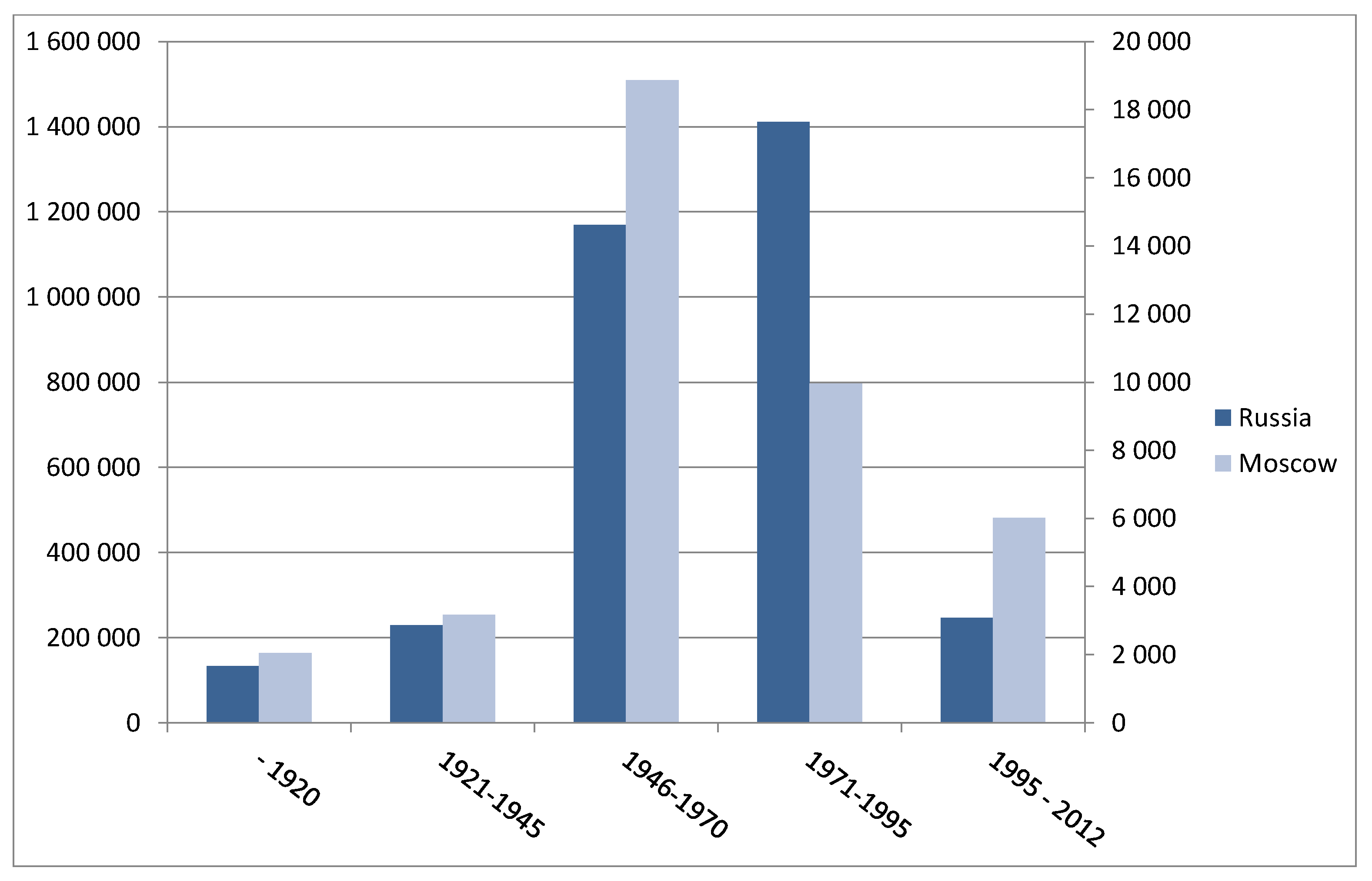
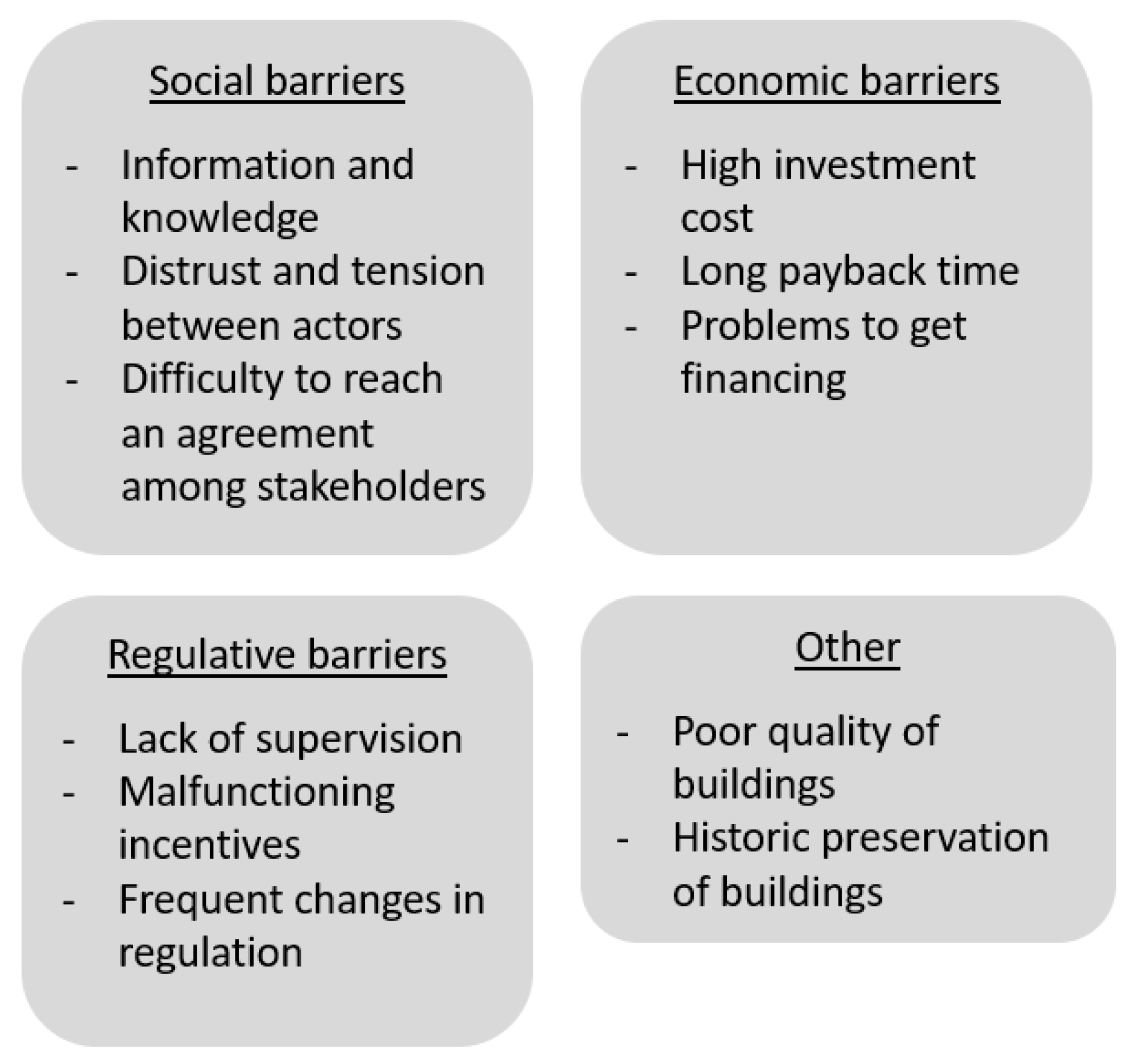
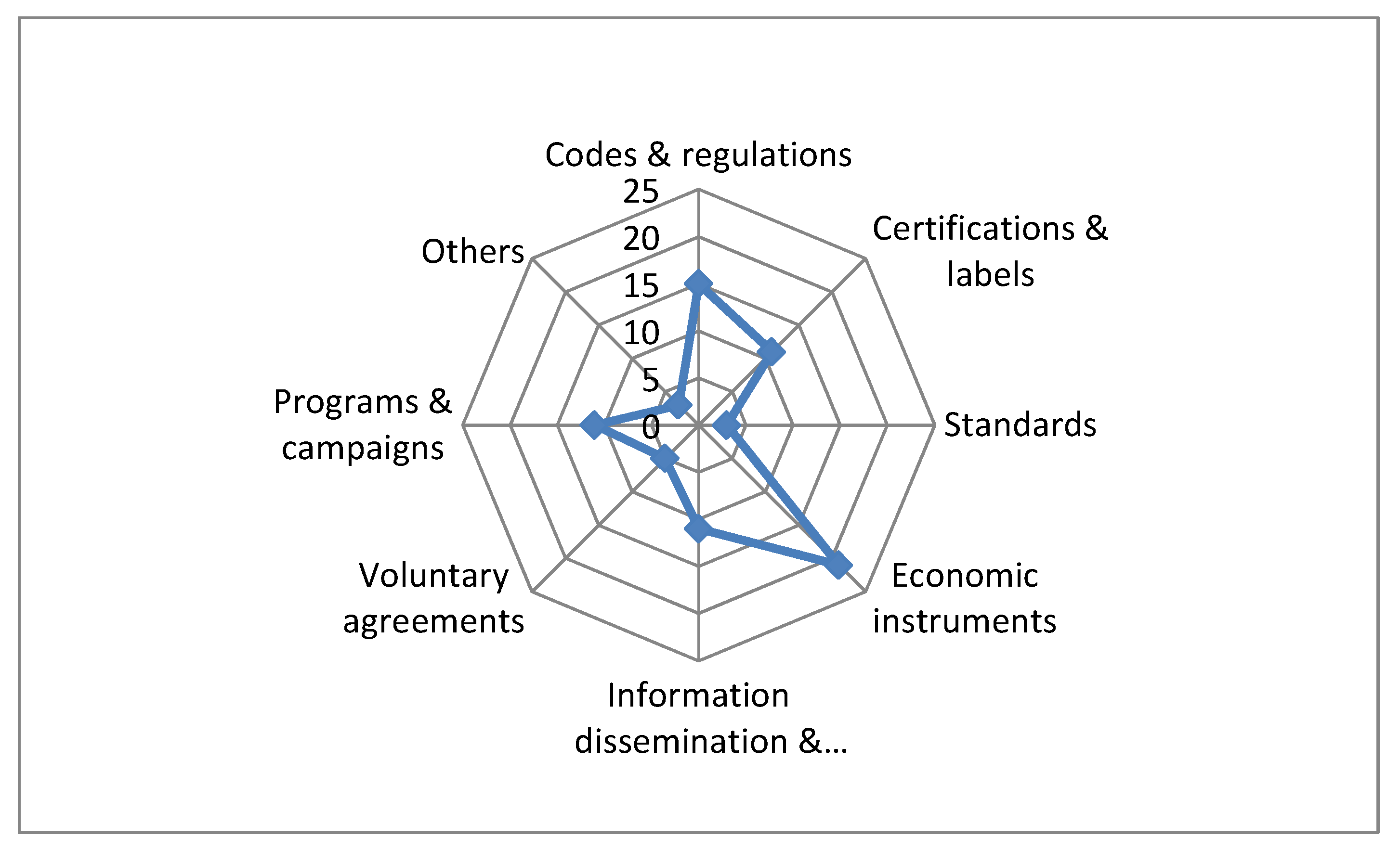
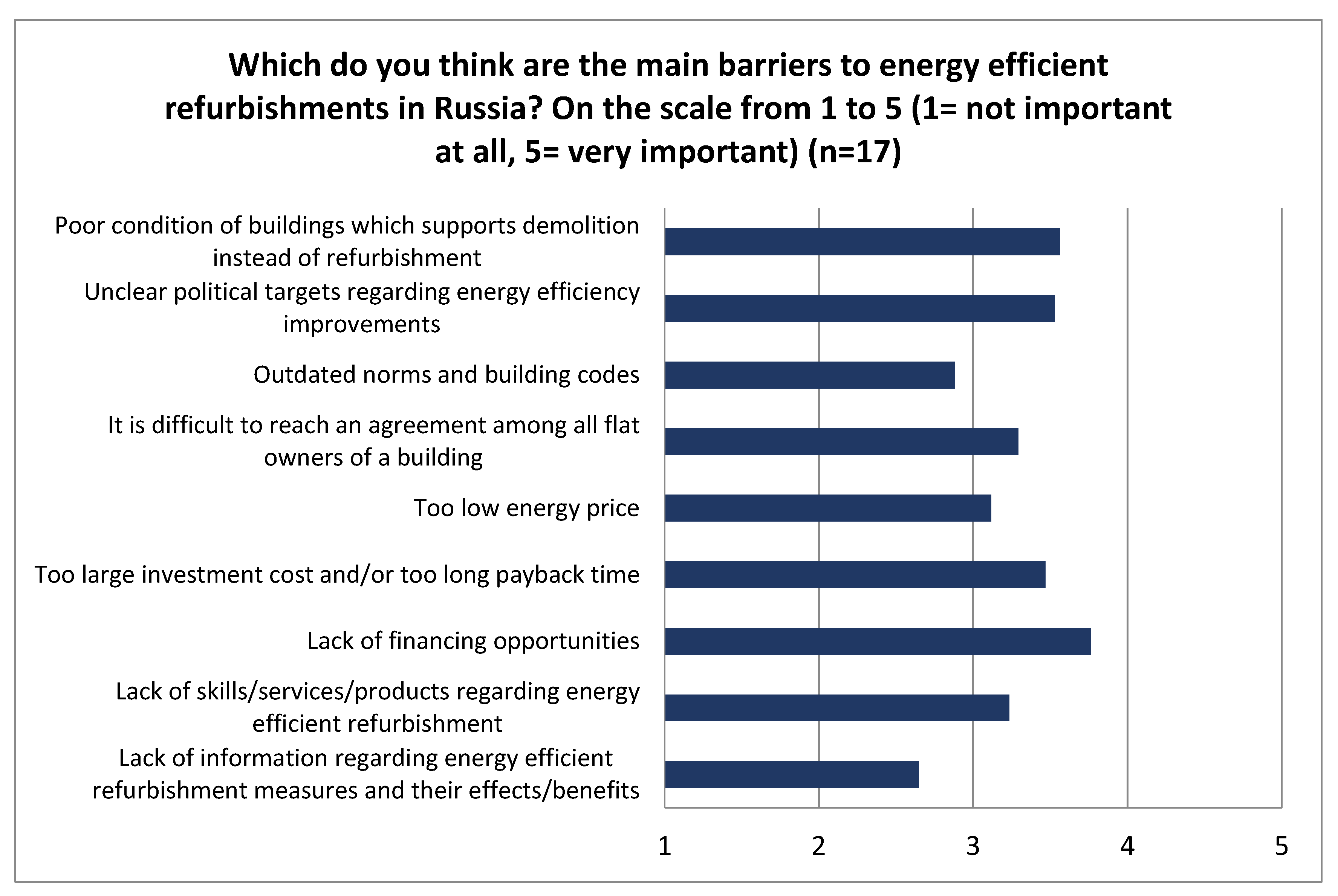



| Reference | Target Sectors | Countries | Codes & Regulations | Certifications & Labels | Standards | Economic Instruments | Information Dissemination & Awareness Raising | Voluntary Agreements | Programs & Campaigns | Others | Comments |
|---|---|---|---|---|---|---|---|---|---|---|---|
| Ástmarsson et al. [56] | rented residential buildings | Denmark | x | x | x | x | x | x | list of instruments, not information given on the effectiveness | ||
| Baek and Park [57] | residential buildings | Denmark, France, Germany, Sweden | x | x | x | x | review how renovation policies are changing, and what political strategies promote housing renovation, no effects reported | ||||
| Baek and Park [46] | residential buildings, mainly single-family houses | Denmark, France, Germany, Korea, Netherlands | x | x | x | x | barriers and instruments introduced, no effects reported | ||||
| Charlier and Risch [58] | households | France | x | evaluation of 4 financial support policies available only if renovations are done by building professionals. In the absence of environmental policies, very few energy-saving renovations are profitable or can be financed by households. Share of “free-riders” about 40%. | |||||||
| Dowling et al. [59] | buildings, energy supply | Australia | x | x | x | x | x | some effects reported, not actual standards for building renovation presented (rather referred to regulations and performance standards) | |||
| Galvin [60] | existing homes | Germany | x | x | cost-effectiveness of building codes, not reported how they would function in practice | ||||||
| Gram-Hanssen [61] | single-family houses | Denmark | x | x | x | no effects reported | |||||
| Gupta et al. [62] | owner-occupied dwellings | UK | x | results of energy retrofits of 27 owner-occupied homes showing energy use reductions | |||||||
| van der Heijden [63] | retrofits of existing buildings | Australia, Netherlands, USA | x | x | voluntary programs may be successful in particular niche markets | ||||||
| Jones et al. [48] | housing stock | UK | x | x | x | programs analyzed for energy savings, CO2 reduction, and costs | |||||
| Karvonen [64] | housing stock | UK | x | x | x | x | introduced community-based partnership includes several stakeholders. Could in some form be applied to Russia. Some examples of the effects given. | ||||
| Korppoo and Korobova [42] | residential heating | Russia | x | x | x | x | x | existing policies analyzed, no known effects at the time of writing, obstacles discussed, possible changes of heat consumption standards (not mentioned which ones) | |||
| Lewis [65] | neighborhoods | Baltimore City, USA | x | x | focus on spatial analyses, probability of residential renovation is examined (i.e., compared to, for example, how close to public transportation) | ||||||
| Lloyd et al. [66] | houses | New Zealand | x | x | physical effects of a government sponsored residential energy efficiency upgrade program, thermal indoor conditions improved since the houses had no insulation before the program | ||||||
| Meijer et al. [67] | residential building stocks | Austria, Finland, France, Germany, Netherlands, Sweden, Switzerland, UK | x | x | x | x | x | some data on the contents and effects of the policies and incentives | |||
| Murphy et al. [68] | residential dwellings | Netherlands | x | x | x | x | x | results demonstrate weak impact of some key instruments | |||
| Murphy [69] | existing dwellings | Denmark, Germany, Sweden, UK | x | x | x | x | instruments between countries differ considerably, little is known about the effects | ||||
| Nauleau [70] | existing homes | France | x | positive effects of tax credits for home insulation reported, share of “free-riders” who would have invested anyway ranged from 40 to 70% | |||||||
| Rosenow et al. [71] | residential buildings | UK | x | x | analysis of budgetary (fiscal) effects of energy efficient programs focusing on solid wall insulation, significant uncertainties in the model | ||||||
| Sunikka [72] | housing stock | European countries, mainly Finland, France, Germany, Netherlands, UK | x | x | x | x | x | analyzing and suggesting policies, no effects reported | |||
| Sunikka-Blank et al. [73] | social housing | UK | x | x | x | results on effects in a case house | |||||
| Tuominen et al. [55] | housing stock | Bulgaria, Czech Republic, Denmark, Germany, Finland, Latvia, Netherlands, Portugal, UK | x | x | x | x | x | x | no realized effects reported, the interest rate of 10% used in cost-effectiveness calculations is too high for most Western European countries, in Russia it is a typical one | ||
| Uihlein and Eder [74] | residential building stock | EU-27 | x | x | potential environmental and economic impacts of two policies analyzed offering energy savings | ||||||
| Weiss et al. [24] | single-family houses | Germany | x | x | x | x | state that the instruments are effective but does not give any evidence on that | ||||
| Number of papers dealing with the issue: | 15 | 11 | 3 | 21 | 11 | 5 | 11 | 3 | |||
© 2017 by the authors. Licensee MDPI, Basel, Switzerland. This article is an open access article distributed under the terms and conditions of the Creative Commons Attribution (CC BY) license (http://creativecommons.org/licenses/by/4.0/).
Share and Cite
Paiho, S.; Ahvenniemi, H. Non-Technical Barriers to Energy Efficient Renovation of Residential Buildings and Potential Policy Instruments to overcome Them—Evidence from Young Russian Adults. Buildings 2017, 7, 101. https://doi.org/10.3390/buildings7040101
Paiho S, Ahvenniemi H. Non-Technical Barriers to Energy Efficient Renovation of Residential Buildings and Potential Policy Instruments to overcome Them—Evidence from Young Russian Adults. Buildings. 2017; 7(4):101. https://doi.org/10.3390/buildings7040101
Chicago/Turabian StylePaiho, Satu, and Hannele Ahvenniemi. 2017. "Non-Technical Barriers to Energy Efficient Renovation of Residential Buildings and Potential Policy Instruments to overcome Them—Evidence from Young Russian Adults" Buildings 7, no. 4: 101. https://doi.org/10.3390/buildings7040101





